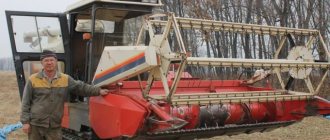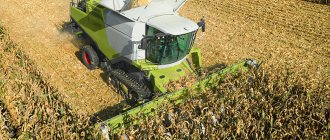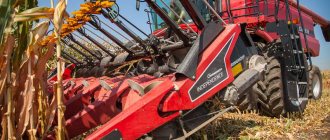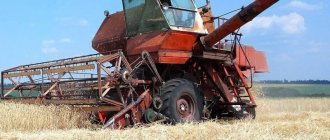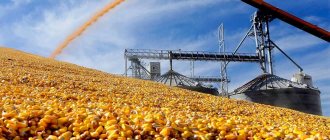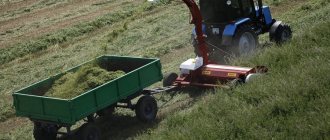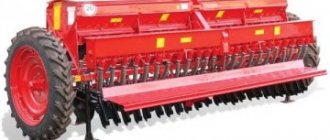Additional equipment for combines increases their functionality. Farmers often use devices for harvesting crops and then processing them. They cut forage plants, grain plants, and root crops. Next, the plants are processed and windrows are formed.
The combine header is a structure with cutting knives. It consists of a base, blade plates, and anti-cut protection. The knives mow down the plants, capturing their stems.
- Mounted models look like attachments to a unit.
- Trailed models are coupled to a tractor and towed.
- Self-propelled harvester headers are equipped with a moving mechanism (wheelbase) and a power unit.
Equipment is selected for tractors depending on their weight and type of clutch. For example, on a Sampo combine harvester you can install a mounted or trailed powerful model.
Purpose and device
The header of the Niva SK 5 combine or other unit consists of several parts.
- Executive agency. Using knife parts, he cuts off the stems. It is assembled from knives, timber, clamps, and a drive mechanism. The dividers carry the crops to the knives, where the cutting occurs.
- Reel. Bends the stems to the executive body. The paddle device processes upright plants. Lifting drums mow down tangled stems of agricultural crops.
- Transport tape. It delivers the cut plants to the ejection window or the receiving window of the thresher.
- Control mechanism. It is needed to adjust the header of a combine harvester, correct installation of the thresher, and cutting height.
The structure of the header is simple, so it can be serviced independently. It is universal, suitable for installation on various units.
Harvester headers - models, technical characteristics, video
The header includes: a housing, a cutting device, a reel, an auger, a balancing mechanism and drive mechanisms.
Frame. In the lower part of the body (left and right) the following shoes are hinged. They can be in four positions, providing a certain cutting height H of the stems when the header is working to follow the field topography. These same shoes can be used as support when servicing, storing or repairing the header.
On the rear wall of the housing (left and right) there are screw jacks designed to secure the header during its installation, storage or repair. On the right side of the rear wall of the housing there are four bipods, which are necessary when installing the reel on the header.
Promotional offers based on your interests:
The body is connected to the spacer at three points: using a central hinge and two suspensions of the balancing mechanism. The header suspension, supported by boots on the soil, ensures that the cutting apparatus follows the field topography in the longitudinal and transverse directions at a given cutting height of the stems.
When the header is working without copying, it is raised by hydraulic cylinders to any height of cutting the stems within 100...1130 mm from the field level...
Depending on the harvesting conditions and the type of crop being harvested, rod dividers or socks are installed on the sidewalls of the header body, forming dividers together with the sidewalls. When harvesting low-growing, tangled barley from the right side of the header, it is recommended to remove the sock. Torpedo-type dividers can be installed.
The cutting apparatus consists of a knife and a finger bar, which is mounted on the front bar of the header. The knife receives a reciprocating motion under the action of a swinging washer mechanism.
The cutting elements of knives come in various designs: with steel double fingers without liners, with open fingers and steel liners. To ensure normal operation, certain clearances are required between the cutting elements. In the front part, the toes of the segments should be adjacent to the liners (a probe 0.1 mm thick passes between them with interference), and in the rear part they should have a gap of 0.3 ... 1.5 mm.
A gap of up to 0.8 mm is allowed for 70% of cutting pairs, 0.8...1.5 mm for no more than 20 and 1.5...2.0 mm for no more than 10% of cutting pairs. The gaps are set using adjusting shims. The gaps between the clamps and segments are no more than 0.7 mm. They are adjusted by bending the clamps.
In a correctly adjusted cutting apparatus, the knife moves under the force of the hand.
The cutting device drive consists of a V-belt drive and a swing washer mechanism.
The V-belt drive includes: a belt, a tension pulley and a bypass pulley. Rotation is transmitted from the counter-drive shaft pulley of the header to the flywheel pulley of the swaying washer mechanism. With normal tension, the deflection of the belt branch is 12… 14 mm. The belt is tensioned by moving the pulley using a tension bolt.
The swashplate mechanism includes: housing, flywheel pulley, drive crankshaft, swashplate, output shaft and lever. The swing washer is mounted on the drive shaft by means of bearings. Except
In addition, it is connected to the output shaft fork with pins on which needle bearings are installed. A lever is attached to the outer end of the shaft. When the drive shaft rotates, the washer transmits a rocking motion to the output shaft and lever. The spherical end of the lever is connected to the head of the movable knife of the cutting apparatus by cheeks. The latter are tightened with a bolt and equipped with a spring.
The reel is used to bring the stems of the harvested crop to the cutting device and feed the cut plants to the header auger. It consists of a central pipe with flanges to which discs with beams are attached. Pipes with spring rakes are hinged at the ends of the beams. The latter can occupy different positions from +15° (forward tilt) to -30° (backward tilt). This is achieved due to the presence of a special configuration of the copier with which the finger interacts.
An eccentric mechanism (on the left and right of the reel) ensures a given tilt of the rake when the reel rotates. This tilt is not adjustable. It changes automatically when the reel is moved horizontally and vertically using a lever system.
The reel is mounted on two independent supports located on the left and right sides of the header. It rotates on two plain bearings. The reel is raised and lowered by two synchronously operating hydraulic cylinders (Fig. 15), and extended by two hydraulic cylinders 6 connected to a lever mechanism. The latter prevents the rake from getting into the header auger. It is possible to further bring the reel closer to the cutting device. For this purpose, you should disconnect the hydraulic cylinders from the reel supports, manually move the reel and fix the supports on the support holes.
When the reel moves forward, the rake fingers tilt back (it is better to lift laying or short stem mass) and vice versa.
The reel is driven by a V-belt variator, a double-circuit chain transmission and a safety friction clutch mounted on the left axle.
Principle of operation
The equipment can be suspended or coupled to units. Some models work independently.
The machines have a similar principle by which they perform bevels.
- The longitudinal bars of the device capture and guide the stems to the cutting devices.
- Knives process agricultural crops.
- The processed silage ends up on the belt.
- The windrows are thrown onto the field or into the machine.
In one pass, the equipment makes a single windrow.
Depending on the power of the tractor itself, the device can achieve high processing speed. Header types:
- Mounted. Used for separate collection of agricultural crops. Cuts and forms sheaves or windrows from stems. The equipment is equipped with an ejection window and a reel with a rake.
- Trailed. Installed on tractors with the power to mow crops. Designed for those farms where the field width is small.
- Self-propelled. A functional model that cuts the stems and then picks them up. As a result, raw material losses are reduced and work productivity increases.
- Combing. The header of a combine harvester uses innovative methods for harvesting grain crops. It acts on the ears, leaving the stems intact. These minimize fuel consumption and equipment wear.
It is advisable to select equipment depending on the width of the field, landscape features, and type of unit. Farmers pay attention to the design features of the models. Then you can perform work with high efficiency and productivity.
Application of the header
The agricultural machinery market offers a wide selection of mechanisms for harvesting various grain crops. Reapers are used both directly for mowing plants and for transporting the cut mass to places for its further processing or laying the harvested crop. Today, several models have been developed with different functional purposes.
- The grain harvester is capable of collecting and windrowing green peas, beans, laid down grain plants and sugar beets. Additionally, this attachment can be used to mow along the contour of fields used for legumes.
- Sunflower header. An indispensable help for farmers during the harvesting of oilseeds. This combine attachment, thanks to the latest developments, makes it possible to harvest crops on lands with complex terrain and different soil covers. Special components ensure reliable operation of the mechanism in any weather conditions: frost, rain, gusty wind. Important characteristics of this attachment are: seed baskets; vibrating conveyor with adjustable speed and channel width, which makes it possible to collect different varieties of sunflower; conveyor for stems. The technical characteristics of the header intended for sunflower do not contradict the use of this attachment for harvesting corn and certain varieties of sorghum.
- Another unit is designed to harvest wheat, rye and oats. which is attached to a combine, tractor or equipped with a self-propelled chassis. The header can immediately feed the cut ears to the combine thresher or place the grain in windrows for subsequent assembly and processing.
Types of harvester headers
Harvesters for agricultural machinery can be classified according to several criteria. Among them:
- cleaning method;
- localization of the cutting part blades;
- features of use;
- principle of autonomy.
According to the first criterion, the headers are:
- screw - for direct combining. In one phase, most mature crops are harvested, as well as low-growing crops and sparse grains, the density of which is up to 300 individuals. stems/1 m2;
- platform – for two-phase combining. They allow you to perform only a few tasks - mowing crops and swathing them. Their design is somewhat different from auger headers. There is also a reel and knives here. Only after cutting and crushing, the harvested crop does not enter the feeder chamber and beater drum, but onto a platform, from which it is transported through the unloading compartment to the windrow stacker.
Depending on the layout of the stem cutters, the following types of headers are distinguished:
Due to the specific application:
- universal – used for a wide range of crops;
- specialized - for a specific agricultural crop.
- mounted headers - are mounted adapters that are attached to a tractor or combine;
- trailed – towed by self-propelled agricultural machinery;
- self-propelled – equipped with a traction mechanism and transport units.


